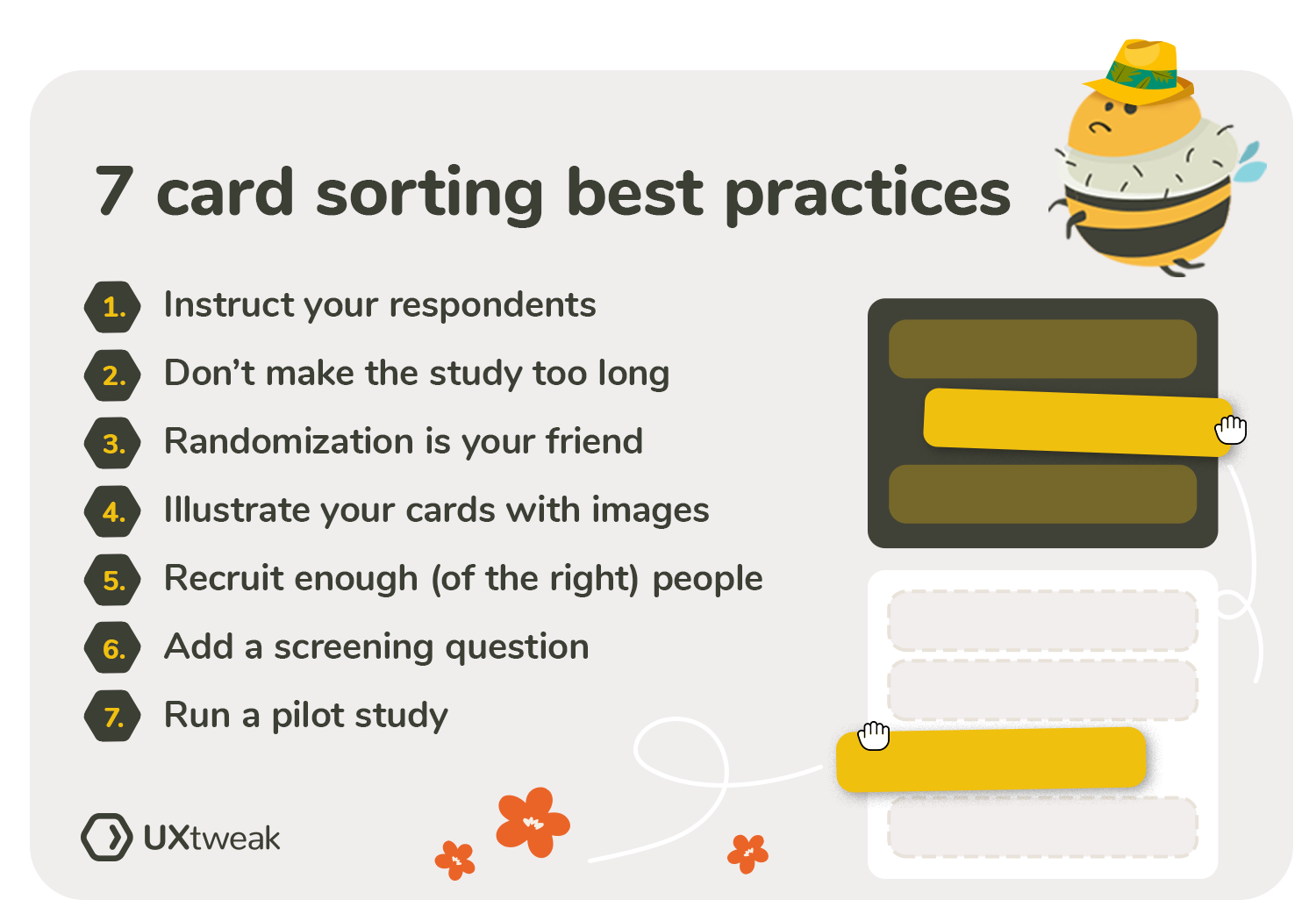There are a couple of useful tips and tricks that you should know about before conducting your first card sorting study. These are the best practices that you should follow in your card sorting in order to obtain insightful and valuable research results. But first, let’s cover the basics.
What is card sorting?
Card sorting is a user experience research technique that involves getting to understand how your users think about the content of your site, app, or other digital product or service. This will allow you to structure and label content in a way that makes sense to your users.
Card Sorting itself is a simple activity to understand. Users categorize individual cards that represent content, in a way they find natural. Learn more about card sorting and its benefits.
How can you conduct card sorting?
Card sorting can be done in two ways: offline or online. Online card sorting is known to be a much more cost-effective and faster method when it comes to harnessing insights. To conduct an online study you’ll need a specialized online card sorting tool in your hands.
A good tool will help you to streamline the analysis process, allows you to easily share study insights, and makes it possible to gather targeted respondents from all over the world in a matter of minutes.
7 card sorting best practices:
To learn about card sorting best practices, continue reading or check our video below. ⬇️
- Instruct your respondents
- Don’t make the study too long
- Randomization is your friend
- Illustrate your cards with images
- Recruit enough (of the right) people
- Add a screening question
- Run a pilot study

Instruct your respondents
At the beginning of each session, you should brief respondents on what’s about to happen. Why are you doing the research that you’re doing? How long will it take them to complete the study? What exactly are they expected to do?
An online card sorting tool should clarify all that in a short welcome message at the beginning of the research activity. Make sure users aren’t confused and are always aware of what they can expect.
Don’t make the study too long
Be aware of participant exhaustion. If you put too much pressure on your users and ask them to sort too many cards, they most likely won’t complete your study. Try to use a maximum of 40 cards per study and make sure it doesn’t take more than 15 minutes to complete each sort.
Need to sort more cards? Cool, some tools such as UXtweak allow you to show respondents a smaller random subset of all cards available. Which brings us to…
Randomization is your friend
Before each card sorting session, don’t forget to shuffle the cards so that no respondent starts with the cards in the exact same order. Each card (and the information on it) will be arranged differently. This will assure that there isn’t a small group of cards that disproportionately affects the strategy by which respondents sort the rest.
Illustrate your cards with images
In addition to words, use photos and pictures to illustrate your cards. This can vastly improve one’s capacity to comprehend the meaning of a card and therefore, the effectiveness of the card sorting effort.
However, even if you’re primarily using images, it’s critical to accurately describe/label the card with text. This will make data analysis more straightforward for you and help the respondent to complete the task easily.
Recruit enough (of the right) people
The best thing about online card sorting is that you can easily recruit a large number of participants. Use this to your advantage and get at least 30-50 respondents for an optimal card sorting experience and accurate statistics.
If your target audience consists of different demographics (e.g., daily and occasional users of your service), don’t forget to recruit sufficiently representative numbers from each of them.
Add a screening question
To guarantee that everyone you recruit matches your target user profile, use a screener at the beginning of a card sorting session. This will filter out the respondents who are not relevant to the study and make sure your results are as accurate as possible.
For example, if you are sorting the content for an online parenting magazine, a good screening question would be: “How many children under the age of 18 do you have living in your household?” with “I neither have nor plan to have children in the near future.” being the screen-out option.
If you’re using an online panel service or even from your own user database, there may be profiling options already available to pre-screen the participants based on your criteria, without the need for a screening question.
Run a pilot study
Before your study is live and sent out to the respondents, find somebody to run a pilot version with. It can be a friend, a colleague, or any other person who didn’t actively participate in creating the card sorting study. This will allow you to estimate the average time needed to complete the study as well as spot possible mistakes in study setup and confusion that may arise.
UXtweak’s Card Sorting tool offers a handy Preview feature that can help you do the pilot by letting you see the study from the user’s point of view before the final launch.
💡Tip: For a more in-depth analysis of IA, you can also combine Card Sorting with screen recordings. It will enrich your IA research with qualitative insights. To learn how you can use UXtweak to set up screen recordings for your Card Sorting, check our video below:
Wrapping up
With these best practices, you are guaranteed to get the best possible results and the most value out of your card sorting study. Use the obtained data to learn more about your users’ mental models and build an intuitive information architecture that guides them toward their goals.
And don’t forget that with UXtweak’s Card Sorting tool you can conduct online card sorting for free! Just register for your free account and start testing today.


